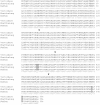Identification of carboxylesterase genes implicated in temephos resistance in the dengue vector Aedes aegypti
- PMID: 24651719
- PMCID: PMC3961196
- DOI: 10.1371/journal.pntd.0002743
Identification of carboxylesterase genes implicated in temephos resistance in the dengue vector Aedes aegypti
Abstract
Background: Thailand is currently experiencing one of its worst dengue outbreaks in decades. As in most countries where this disease is endemic, dengue control in Thailand is largely reliant on the use of insecticides targeting both immature and adult stages of the Aedes mosquito, with the organophosphate insecticide, temephos, being the insecticide of choice for attacking the mosquito larvae. Resistance to temephos was first detected in Aedes aegypti larvae in Thailand approximately 25 years ago but the mechanism responsible for this resistance has not been determined.
Principal findings: Bioassays on Ae. aegypti larvae from Thailand detected temephos resistance ratios ranging from 3.5 fold in Chiang Mai to nearly 10 fold in Nakhon Sawan (NS) province. Synergist and biochemical assays suggested a role for increased carboxylesterase (CCE) activities in conferring temephos resistance in the NS population and microarray analysis revealed that the CCE gene, CCEae3a, was upregulated more than 60 fold in the NS population compared to the susceptible population. Upregulation of CCEae3a was shown to be partially due to gene duplication. Another CCE gene, CCEae6a, was also highly regulated in both comparisons. Sequencing and in silico structure prediction of CCEae3a showed that several amino acid polymorphisms in the NS population may also play a role in the increased resistance phenotype.
Significance: Carboxylesterases have previously been implicated in conferring temephos resistance in Ae aegypti but the specific member(s) of this family responsible for this phenotype have not been identified. The identification of a strong candidate is an important step in the development of new molecular diagnostic tools for management of temephos resistant populations and thus improved control of dengue.
Conflict of interest statement
The authors have declared that no competing interests exist.
Figures






Similar articles
-
Transcriptome Profiling and Genetic Study Reveal Amplified Carboxylesterase Genes Implicated in Temephos Resistance, in the Asian Tiger Mosquito Aedes albopictus.PLoS Negl Trop Dis. 2015 May 22;9(5):e0003771. doi: 10.1371/journal.pntd.0003771. eCollection 2015 May. PLoS Negl Trop Dis. 2015. PMID: 26000638 Free PMC article.
-
Functional and immunohistochemical characterization of CCEae3a, a carboxylesterase associated with temephos resistance in the major arbovirus vectors Aedes aegypti and Ae. albopictus.Insect Biochem Mol Biol. 2016 Jul;74:61-7. doi: 10.1016/j.ibmb.2016.05.007. Epub 2016 May 13. Insect Biochem Mol Biol. 2016. PMID: 27180726
-
Temephos resistance in Aedes aegypti in Colombia compromises dengue vector control.PLoS Negl Trop Dis. 2013 Sep 19;7(9):e2438. doi: 10.1371/journal.pntd.0002438. eCollection 2013. PLoS Negl Trop Dis. 2013. PMID: 24069492 Free PMC article.
-
In silico models for predicting vector control chemicals targeting Aedes aegypti.SAR QSAR Environ Res. 2014;25(10):805-35. doi: 10.1080/1062936X.2014.958291. Epub 2014 Oct 2. SAR QSAR Environ Res. 2014. PMID: 25275884 Free PMC article. Review.
-
Review of insecticide resistance and behavioral avoidance of vectors of human diseases in Thailand.Parasit Vectors. 2013 Sep 25;6:280. doi: 10.1186/1756-3305-6-280. Parasit Vectors. 2013. PMID: 24294938 Free PMC article. Review.
Cited by
-
Gradual reduction of susceptibility and enhanced detoxifying enzyme activities of laboratory-reared Aedes aegypti under exposure of temephos for 28 generations.Toxicol Rep. 2021 Nov 24;8:1883-1891. doi: 10.1016/j.toxrep.2021.11.013. eCollection 2021. Toxicol Rep. 2021. PMID: 34900604 Free PMC article.
-
In the hunt for genomic markers of metabolic resistance to pyrethroids in the mosquito Aedes aegypti: An integrated next-generation sequencing approach.PLoS Negl Trop Dis. 2017 Apr 5;11(4):e0005526. doi: 10.1371/journal.pntd.0005526. eCollection 2017 Apr. PLoS Negl Trop Dis. 2017. PMID: 28379969 Free PMC article.
-
Carboxylesterase gene amplifications associated with insecticide resistance in Aedes albopictus: Geographical distribution and evolutionary origin.PLoS Negl Trop Dis. 2017 Apr 10;11(4):e0005533. doi: 10.1371/journal.pntd.0005533. eCollection 2017 Apr. PLoS Negl Trop Dis. 2017. PMID: 28394886 Free PMC article.
-
Knockdown resistance (kdr) mutations within seventeen field populations of Aedes albopictus from Beijing China: first report of a novel V1016G mutation and evolutionary origins of kdr haplotypes.Parasit Vectors. 2019 Apr 24;12(1):180. doi: 10.1186/s13071-019-3423-x. Parasit Vectors. 2019. PMID: 31014392 Free PMC article.
-
Expansive and Diverse Phenotypic Landscape of Field Aedes aegypti (Diptera: Culicidae) Larvae with Differential Susceptibility to Temephos: Beyond Metabolic Detoxification.J Med Entomol. 2022 Jan 12;59(1):192-212. doi: 10.1093/jme/tjab179. J Med Entomol. 2022. PMID: 34718656 Free PMC article.
References
-
- Nimmannitya S, Thisyakorn U, Hemsrichart V (1987) Dengue haemorrhagic fever with unusual manifestations. The Southeast Asian journal of tropical medicine and public health 18: 398–406. - PubMed
-
- Paeporn P, Ya-umphan P, Supaphathom K, Savanpanyalert P, Wattanachai P, et al. (2004) Insecticide susceptibility and selection for resistance in a population of Aedes aegypti from Ratchaburi province, Thailand. Tropical Biomedicine 21: 1–6. - PubMed
-
- Swaddiwudhipong W, Lerdlukanavonge P, Khumklam P, Koonchote S, Nguntra P, et al. (1992) A survey of knowledge, attitude and practice of the prevention of dengue hemorrhagic fever in an urban community of Thailand. The Southeast Asian journal of tropical medicine and public health 23: 207–211. - PubMed
-
- Juntarajumnong W, Pimnon S, Bangs MJ, Thanispong K, Chareonviriyaphap T (2012) Discriminating lethal concentrations and efficacy of six pyrethroids for control of Aedes aegypti in Thailand. Journal of the American Mosquito Control Association 28: 30–37. - PubMed
Publication types
MeSH terms
Substances
LinkOut - more resources
Full Text Sources
Other Literature Sources
Molecular Biology Databases
Research Materials
Miscellaneous

